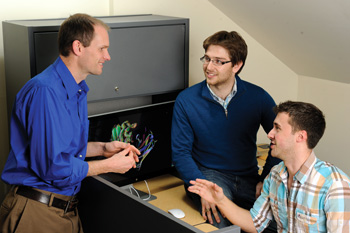In recent years, a sophisticated computer program called Rosetta—a protein structure prediction program created by a consortium of laboratories that includes Johns Hopkins University— has made the task of predicting protein structure quicker and more cost-effective. This is essential to designing new proteins to fight diseases such as HIV, malaria, and cancer. But the level of programming proficiency required can be a barrier for even the most seasoned scientists, much less the typical university student.

As a postdoctoral fellow, Jeffrey Gray, an associate professor of chemical and biomolecular engineering and F. Stuart Hodgson Faculty Scholar at the Whiting School, wrote algorithms that helped lay the foundation for Rosetta. Now he’s embarked on a project to harness Rosetta’s power in a more accessible programming language (Python) with PyRosetta. “The long-term goal is to make [Rosetta] part of the toolbox for the life sciences,” he says.
But Gray has found another important audience: students in his computational protein structure prediction and design class. He recalls, “The first time I taught [the course], I lectured. We read papers. We did things on the chalkboard. It was exciting. They learned. But it was dry. Students didn’t really get a chance to get their hands on it.”
Today, Gray’s class is built on PyRosetta, allowing students to learn the software from the ground up and even create award-winning projects—as Nicholaus Trenton, a The Fast Lane to Proteins senior majoring in chemical and biomolecular engineering, did earlier this year.
Trenton teamed up with Hopkins biomedical engineering doctoral student Brian Ross on a project that used PyRosetta to attack a sticky problem: A protein complex called FKRP-rapamycin- FRB is key to the study of cell dynamics because it forms only in the presence of the immunosuppressant drug rapamycin. But the bonding of the protein complex is not easily reversible, making it impossible to track its eventual breakdown using live cell imaging methods.
Trenton and Ross used PyRosetta to predict 12 mutations of the complex that might lessen the bond with rapamycin without destroying the protein completely, giving researchers a potential map of possibilities for new lab work. Their project won the 2012 Rosetta Design Group Corey Award for undergraduates and beginning graduate students who show “creativity and boldness in the field of macromolecular structure prediction and design.”
“This field is really new,” Trenton says, of mapping proteins and predicting their behavior. “PyRosetta is how everyone is going to be doing this in 10 or 15 years.”
Gray’s efforts have received funding from the National Institutes of Health and National Science Foundation, and he is planning a series of webcasts on PyRosetta (with some student help) to meet growing demand from researchers.
PyRosetta’s classroom applications also ensured that Gray received support from Hopkins’ Center for Educational Resources through its Technology Fellowship, which has faculty and students collaborate to develop new resources for Hopkins courses.
“Dissemination of the work is part of the process,” says Richard Shingles, a lecturer in Biology who served as the CER’s curriculum design consultant liaison on PyRosetta. “As educators, we’re really happy.”




